By Mary Ann Foster
Originally published in Body Sense magazine, August/Winter 2005.
Stretching is such an integrated part of many natural movements that it creeps into our daily activities whether we plan it or not. First thing upon waking, most of us sit up, yawn, and stretch without actually thinking about it. After a long trip in a car or airplane, we stretch our legs to get them moving again. Even a sudden cramp can have us reflexively jumping up and hopping around to stretch for relief.
Stretching is so instinctive that sometimes we don’t realize how we can consciously shape it. Like any sport or activity, the effectiveness of stretching can be greatly enhanced if practiced with good form. Following are a few tips designed to help you improve your stretching form.
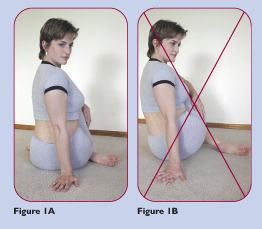
1. When in a seated stretch, keep both hips on the ground.
The tissues elongated by stretching, particularly the muscles and fascia (myofascia), wrap the body like smooth, supple fabric. To put even pulls on this endless web of elastic fibers, keep both hips touching the ground as you stretch. By doing so, you maintain symmetry (Figure 1A). Avoid hiking one hip, which puts uneven torsion on your joints, creating a muscle length imbalance that has pulled many a pelvis and lower spine out of alignment (Figure 1B).
When crossing one leg over another in a seated position, avoid twisting your spine by keeping both hips firmly seated on the chair.
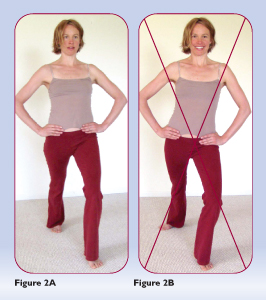
2. Always face in the direction of the stretch, keeping your hips and shoulders square.
When the skeletal architecture is symmetrical and balanced, the muscles hug the body like a well-tailored suit. By facing the direction in which you are stretching, you keep your bones and joints in good alignment and more effectively stretch target muscles.
For example, to effectively stretch the hip flexors, the hips, knees, and feet all need to face the same direction and the hips need to be level (Figure 2A). By facing forward and keeping the hips and shoulders squared and level, you avoid unnecessary rotation in the limbs and misalignment in the spine (Figure 2B). Poor alignment not only puts unnecessary torque on your joints (which could lead to strain and sprain), it fails to put the tissues being stretched under adequate tension to accomplish the job. Also, improper positioning often causes people to try to stretch farther and harder, increasing the likelihood of injury.
When reaching across your desk or table, face the direction you are reaching. This will help you avoid muscle or joint strain from the compensatory twisting.
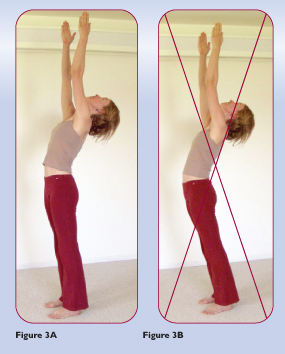
3. When bending the trunk into a stretch, protect your back by contracting your abdominal muscles.
The abdominal muscles wrap the waist like a corset. Letting the belly hang out is akin to having a small sack of potatoes hanging from the waist, placing a potentially damaging load on the lower back. To make sure this doesn’t happen to you, always lightly contract your abdominal muscles when stretching in any direction (Figure 3A). When bending backward, the weight of the sagging viscera can compress or pinch sensitive structures in your lower back (Figure 3B). In fact, research evidence shows that contracting the deep lower abdominal muscles activates postural muscles, which protect the lower back from pain and injury.
Keep your lower abdominal muscles lightly contracted during all activities, such as bending over to tie your shoes, riding a bike, lifting, and even when walking or sitting. Since these postural muscles are fatigue resistant, you should be able to hold them all day without tiring.
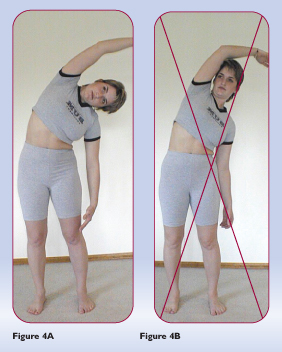
4. Reach into a stretch from one end of your body to the other.
Rather than placing your body in a position of static stretch, reach into a dynamic stretch. Go slowly. Keep the stretch going as though there is no end point, no place to get to. Keep reaching to gradually lengthen into the stretch. Reaching pulls through the elastic fibers of your muscles and fascia from one end of the body to the other, decompressing your joints and making each stretch a full-body movement (Figure 4A). Without the reach, the body tends to collapse and compress the joints (Figure 4B).
While sitting, reach the top of your head toward the ceiling; while walking, reach your heel out in front on each step. Reach into all activities with a full commitment to keep your joints decompressed and muscles elongated.
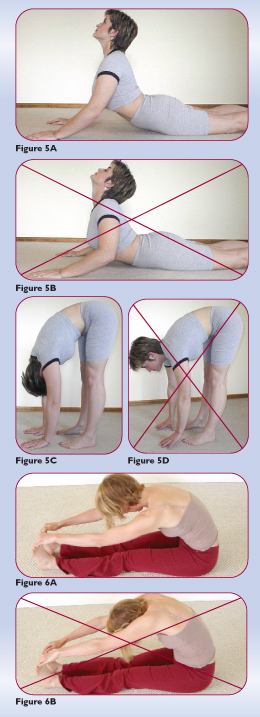
5. Keep your head and neck connected to your spine in every stretch.
Stretching not only elongates tissues, it trains your muscles to work in integrated and coordinated chains of action. While stretching, let your head be an extension of your spine. Reach through the top of your head as you arch the back into a cobra stretch (Figure 5A). Avoid letting the head fall back because the neck is particularly vulnerable to injury from bending stresses, especially hyperextension (Figure 5B).
When doing a forward bending stretch, let your head hang into flexion. In doing so, the weight of the head lengthens the long muscles along the entire spine (Figure 5C). Avoid lifting the head, which breaks the continuity of the stretch and can strain the back of the neck (Figure 5D).
When reaching out for any reason, remember to reach through the top of your head as well. This helps to keep your head supported and your neck long. When bending forward, allow your head to go forward, too. This gives your neck muscles a lengthening moment.
6. Relax your shoulders and let them be wide in every stretch.
Like the widest parts of a yoke, our shoulders like to live on the sides of the body instead of slumped forward or pulled back. As you stretch, balance your shoulders by staying wide in both the front and back, across the chest, and between the shoulder blades (Figure 6A). Avoid hiking the shoulders (remember — shoulders don’t make good earmuffs). Hiking disorganizes the shoulder muscles, overstretching some tissues while failing to adequately lengthen others, rounding the upper back, and crowding the neck. Hiking also puts pressure on vital nerves that supply the arms, which could lead to numbness and pain (Figure 6B).
Although easy to do, it takes mental discipline to keep the shoulders relaxed so that your arms can hang naturally by your sides and swing easily as you walk.
***
Whether you are aware of it or not, in everything you do you are always training the body for something, reinforcing either good or bad habits. Slouch while you sit and you train your muscles to slouch. Sit up straight and you train your muscles to provide optimal postural support. Stretching is no exception. An optimal stretching routine should sculpt a balanced, upright body that you can enjoy calling home. So take advantage of something you do naturally. Stretch with good form and you will not only look and feel better, but good form will likely spill over into all your daily activities.




